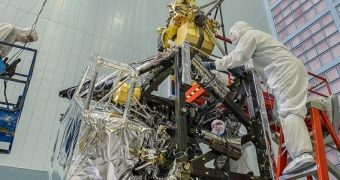Officials with the American space agency announce the successful integration of the Near Infrared Camera (NIRCam) instrument with the James Webb Space Telescope (JWST) spacecraft bus at its Goddard Space Flight Center (GSFC) in Greenbelt, Maryland. This is a critically-important milestone for developing the world's largest and most advanced space telescope.
The procedure took place this month inside the largest clean room ever constructed, which is housed at the GSFC. The NIRCam is one of the most important scientific instruments on the telescope, alongside the Near IR Spectrograph (NIRSpec), the Mid IR Instrument (MIRI), and the Near Infrared Imager and Slitless Spectrograph (NIRISS).
Since NIRCam is an extremely large and sensitive piece of equipment, GSFC engineers had to be very careful while maneuvering it inside its slot on the telescope's Integrated Science Instrument Module (ISIM). When the entire integration process is complete, ISIM will hold all four of JWST's main science instruments.
NIRCam was the first to be installed because it is the primary image on NASA's next flagship telescope. It will survey the Universe at wavelengths between 0.6 to 5 microns in the infrared portion of the electromagnetic spectrum and will be able to detect light released by the earliest stars and galaxies to have developed in the Universe.
“Installing NIRCam into the center of the structure is nerve wracking because of the tight clearances. I'm glad nothing bumped, and all the bolts are in place,” says the principal investigator for the instrument, Marcia J. Rieke. She holds an appointment as a professor of astronomy with the University of Arizona in Tempe.
The expert adds that NIRCam will play an important role as a wavefront sensor. This is a piece of equipment designed to provide vital information to the computers aboard JWST about how its 18 hexagonal mirror segments should be moved and repositioned in order to increase image clarity.
NIRCam, which was provided to NASA by engineers at UAT and the Lockheed Martin Advanced Technology Center, will also be involved with exoplanetary studies. Astronomers hope to use the instrument to detect thousands of new celestial bodies inside our own galaxy. NIRCam will also reveal the existence of young protostars inside their thick cocoons of gas and dust.
Now that integration of NIRCam is complete, GSFC engineers will begin cryogenic testing of the entire ensemble in order to figure out how the instrument will handle the ultra-low temperatures it will encounter in space. JWST is currently tentatively scheduled to launch by 2018.

 14 DAY TRIAL //
14 DAY TRIAL //